
Now that we’ve got one eye on our frock and the other on our husband, it’s a good moment to look back with some anger and sadness and to get facts straight. In the eighties I had a copy of Heinz Heger’s The Men with the Pink Triangle but, as they say, it got lost in the move. I’ve just ordered a replacement from a secondhand bookshop in Berlin, where I’m writing this. It’s cheaper to have it posted home than to cross town to Buchhandel Freitag in Moabit and pick it up.

Heger’s testimony of survival in the Nazi camps and his history of the deportation and murder of homosexuals is, as far as I know, a first book-length account of this long-unacknowledged persecution. An article by Wolfgang Harthauser, ‘The Mass Murder of Homosexuals Under the Third Reich’ appeared as late as 1967, at a time when homosexuality itself was beginning to be decriminalised. Heger was an Austrian Catholic whose real name was Josef Kohout (1917-1994). His 1972 book was published in translation by The Gay Men’s Press in London in 1986.
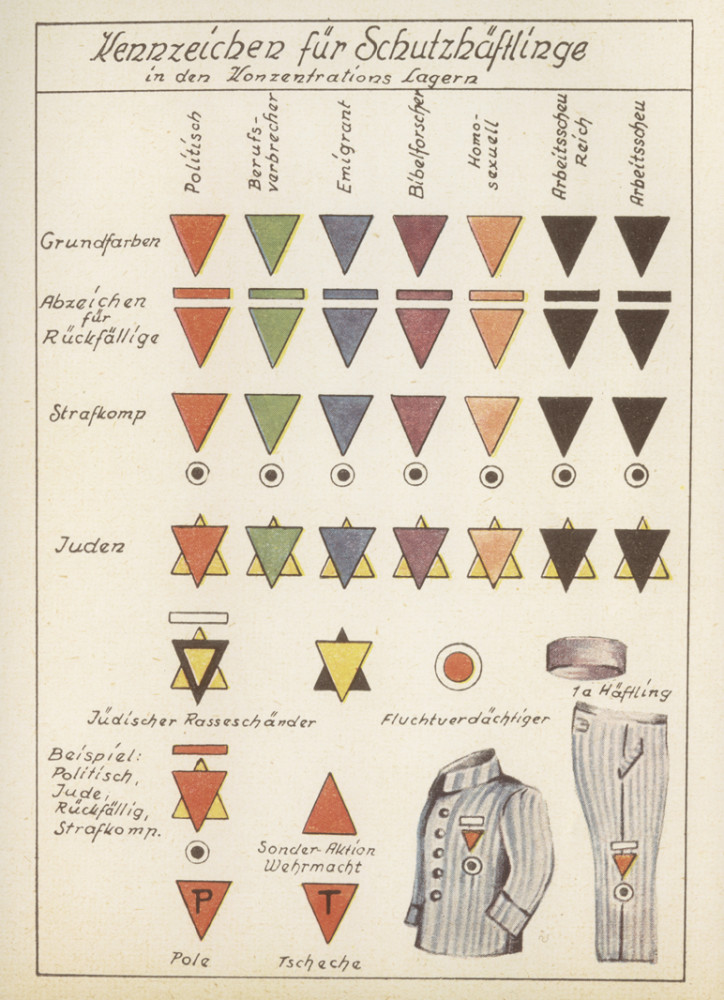
The various categories of inmate and their applicates
The pink triangle designated homosexuals in the camps where, with characteristic German thoroughness, each category of inmate had his or her own symbol. Persecution began right from 1933, under the infamous Paragraph 175 of the legal code, which had been little enforced until Hitler came to power. All it took was a lingering look, a pick-up in a bar or a history in the police files. In the case of Josef Kohout, it was an intercepted Christmas card to his lover. Lesbianism wasn’t on the Nazi statute books: Kinder, Küche, Kirche (children, kitchen, church) was felt to be enough to keep wayward women in line. In all, 50,000 homosexuals were officially sentenced and between 5,000 and 15,000 were sent to concentration camps where the death rate was as high as 60%.
The 22-year-old university student Kohout spent his first two weeks in a cell with a house-breaker and a swindler. When he refused their propositions, they:
started to insult me and ‘the whole brood of queers’, who ought to be exterminated. It was an unheard-of insult that the authorities should have put a sub-human such as this in the same cell as two relatively decent people. Even if they had come into conflict with the law, they were at least normal men and not moral degenerates. They were on a quite different level from homos, who should be classed as animals. (1)
Of course the ‘relatively decent people’ didn’t stop at insults but progressed to forced oral sex. This becomes the standard response to the plight of homosexuals in the larger concentration camp population.
Jews, homosexuals and gypsies, the yellow, pink and brown triangles, were the prisoners who suffered most frequently and most severely from the tortures and blows of the SS and the Capos. They were described as the scum of humanity, who had no right to live on German soil and should be exterminated … But the lowest of the low in this ‘scum’ were we, the men with the pink triangle.
Kohout recounts how compensation was refused after the war, how many former concentration camp prisoners who had worn the pink triangle were put right back in prison again. The incriminating Paragraph 175 remained in force in West Germany until 1979. By century’s end, not one had received legal recognition as a victim of the Nazi regime.
The Josef Kohout/Wilhelm Kroepfl Collection at the United States Holocaust Memorial Museum is a unique set of documents. It includes Josef’s pink triangle and prison number, letters from his parents, the paraphernalia of a concentration camp life.
Memorials to homosexual persecution under the Nazis began appearing in the 1980s, with some lingering opposition. Since then, other stories have emerged into the more tolerant climate of the late twentieth century. But documentation and memory race against time. Many former homosexual prisoners were understandably reluctant to come forward. And they had to contend with people and organisations who wanted to circumscribe and manage their truth for them.
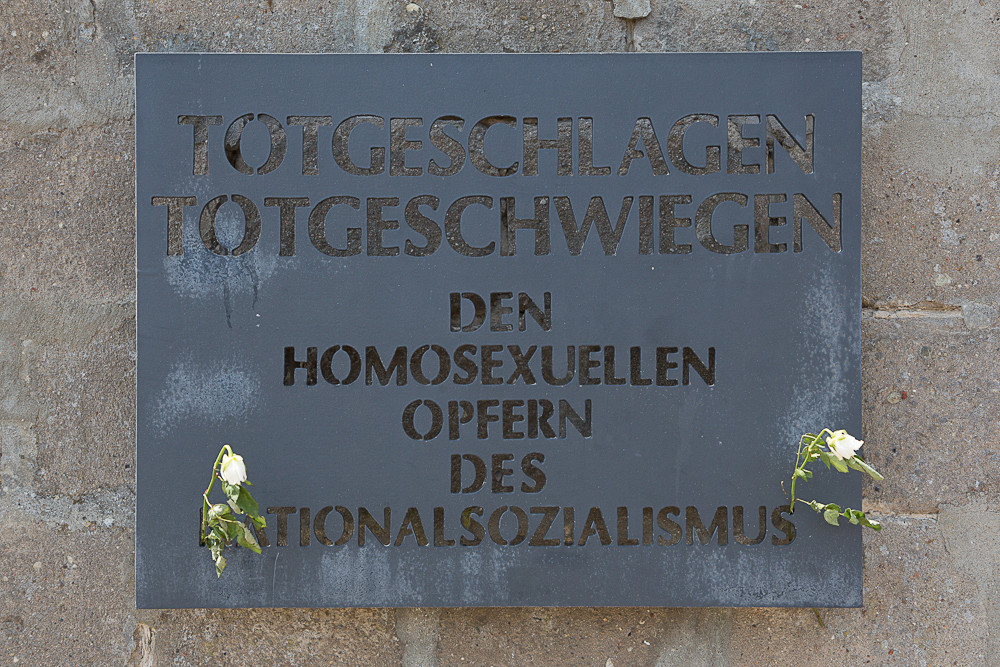
Sachsenhausen concentration camp memorial plaque
One who interested me was Pierre Seel, an Alsatian who testified initially in 1981 to his deportation and published his memoirs in 1994: Moi, Pierre Seel, deporté homosexuel. I came across his account on a school tour to the former camp at Natzweiler-Struthof. Seel was from Mulhouse, across the border from Basel. At age 17 he reported the theft of a watch from a notorious cruising park, Le Square Steinbach. His name was surrepticiously added to the register of known homosexuals.

Rounded up by the Gestapo, tortured, Seel was transported to Schirmeck near Strasbourg. His account is not just a record of the war years but also a testament to local resistance to memory. Whose memory? What will be memorialised and what obliterated? What is the hierarchy of memory and suffering? Who gets invited to the ceremonies? Which groups get the wreaths? Memorials to homosexual deportation were not granted: they had to be fought for. It’s not just that gay history under the Third Reich was forgotten, it’s that it was deliberately suppressed. Seel received death threats from right-wingers in the 1980s. The stigma of AIDS was in the air du temps. The mayor of Strasbourg, Catherine Trautmann, refused to shake his hand.

My memory of The Men with the Pink Triangle was prompted by a visit yesterday to the memorial to deported homosexuals here in Berlin. It’s at the Eberstrasse end of the Tiergarten, facing the larger and more imposing Jewish Holocaust Memorial. There was an apt quietness and discretion to the Memorial to Homosexuals Persecuted under Nazism (Denkmal für die im Nationalsozialismus verfolgten Homosexuellen), to give it its full title. You come upon it in the bushes by the Goethe Denkmal, almost by surprise. The memorial was designed by Michael Elmgreen and Ingar Dragset and erected in 2008.

In 1933 there were about 130 gay bars in Berlin. The Tiergarten was a well known cruising ground as well as a place for either gender to pick up soldiers. Cabaret, notably Hanna Sturm, was all the rage at clubs such as the Eldorado, the Owl and the Olivia.
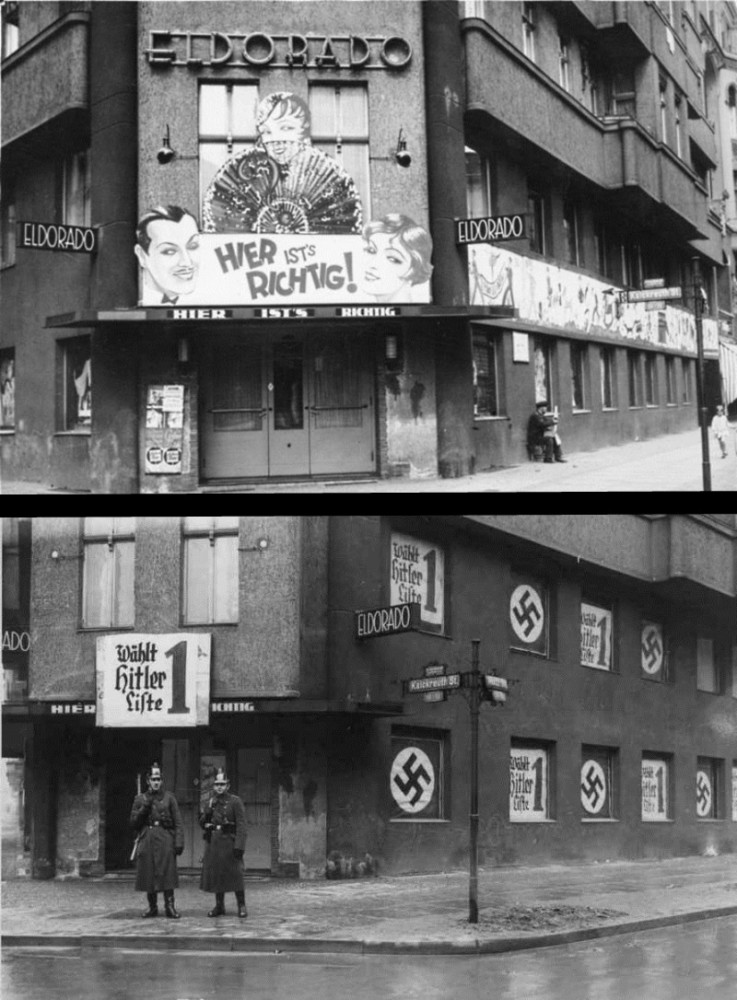
The Eldorado Club before and after the Nazi takeover
Then as now, bars had their specialities. The satirical Parisian newspaper Le Crapouillot reported in 1931 on Zum Kleinen Löwen (The Lion Cub):
… modeled on the saloon bars of the Wild West, with flags of all nations hanging from the ceiling, and a lively crowd. Service was provided by ‘young lions’, in other words, strapping lads of 18 to 20, well built and bursting with health, dressed as sailors, attentive to clients who also had a taste for butcher boys.
Christopher Isherwood immortalised this world in his writing and the film Cabaret turned it into mass audience family viewing.
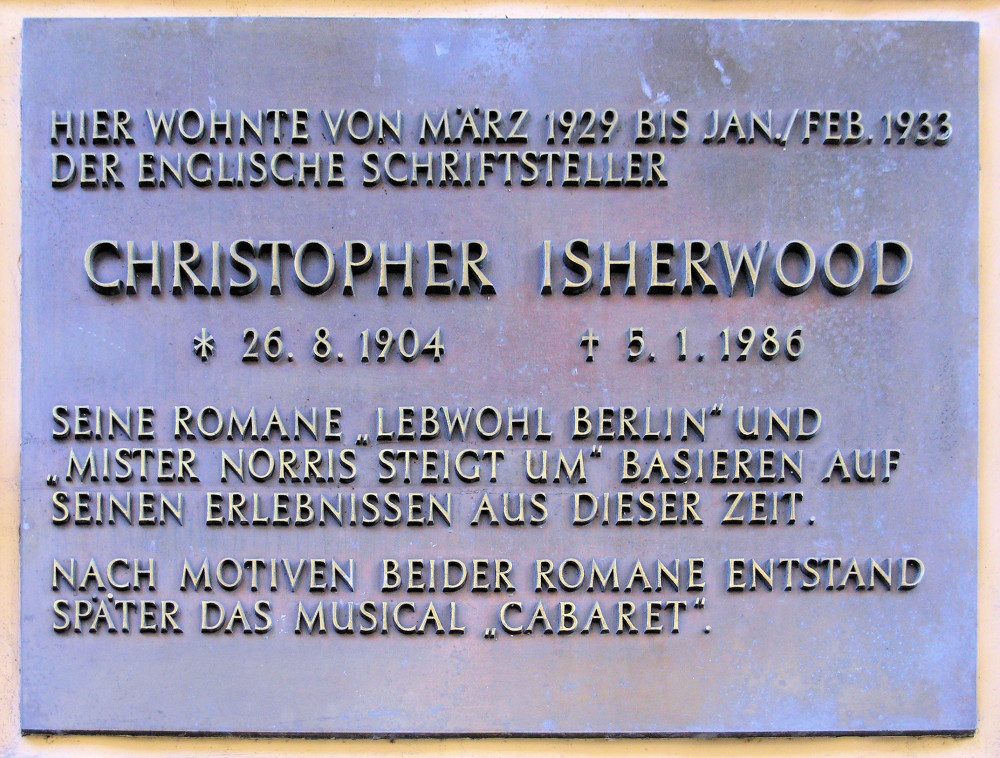
Willy, Colette’s first husband, in The Third Sex (Paris, 1927), describes a bar called The Cosy Corner, which Isherwood introduced him to:
Tourists avoided it because it was a bit dodgy. In fact, this establishment survived on its regulars and there was nothing decadent about it: it was decorated with photos of boxers and racing cyclists. Frequented by young unemployed labourers, in leather jackets, shirt open to the navel, sleeves rolled up, they played cards while waiting on clients.(2)

Transvestites at the Eldorado, early 1930s
We should not allow piety to obscure the liveliness and true character of homosexuality under the Weimar Republic, in all its diversity. Especially so in our time, when ‘diversity’ and the gay marriage debate have brought homosexuality into the bourgeois fold, and thereby sanitised it. In the excellent documentary Paragraph 175 (2000), one octogenarian gay Berlin survivor says: “While the bombs were falling, we made love on the trains!” I have heard the same thing about London during the Blitz.

Mugshots of Johann Scheff, arrested in Berlin in 1932
Recognition of homosexual victims of Nazism was late in coming. Change does sometimes spring from the largesse of the hetero-normative heart. But methinks more often than not change needs to be forced, when not granted. The heart did not bring about the abolition of slavery: hard political pressure, a civil war and the mechanisation of labour all played a role. Ditto for gay rights: people put their neck, their job, their reputation on the line.
Reading these accounts of former detainees in the post-war world, it’s clear that homosexuals were treated as criminals whereas Jews were seen as victims. After the war, the heart was partisan. What did it feel like to return to those provincial French and German towns under the Fourth Republic and Konrad Adenauer with the stigma of criminal, to have no legitimate grievance? Never to speak of your wartime experience, as though it had never happened. To hide the incriminating pink triangle at the bottom of a shoebox. Towns where people knew and nobody cared, busy as they were with rebuilding, with moving on, with the small change of family life, the confirmations, graduations, marriages. To walk the park and see the neighbour who betrayed you. To see the friend you’d slept with marry the girl next door.
The quality of mercy is not strain’d,
It droppeth as the gentle rain from heaven
Upon the place beneath
One theme that emerges from these accounts it that, given an opportunity, men took their pleasure and ran. Camp guards, fellow prisoners, family men used and abused homosexuals with impunity: because they were there. What has come to be called ‘rape culture’ has a long and odious history. But counterbalancing this are a number of benevolent acts; the Kapo who hid a prisoner among the pigs because he knew the Americans would soon come, incidents of solidarity in the 1930s German homosexual underworld.
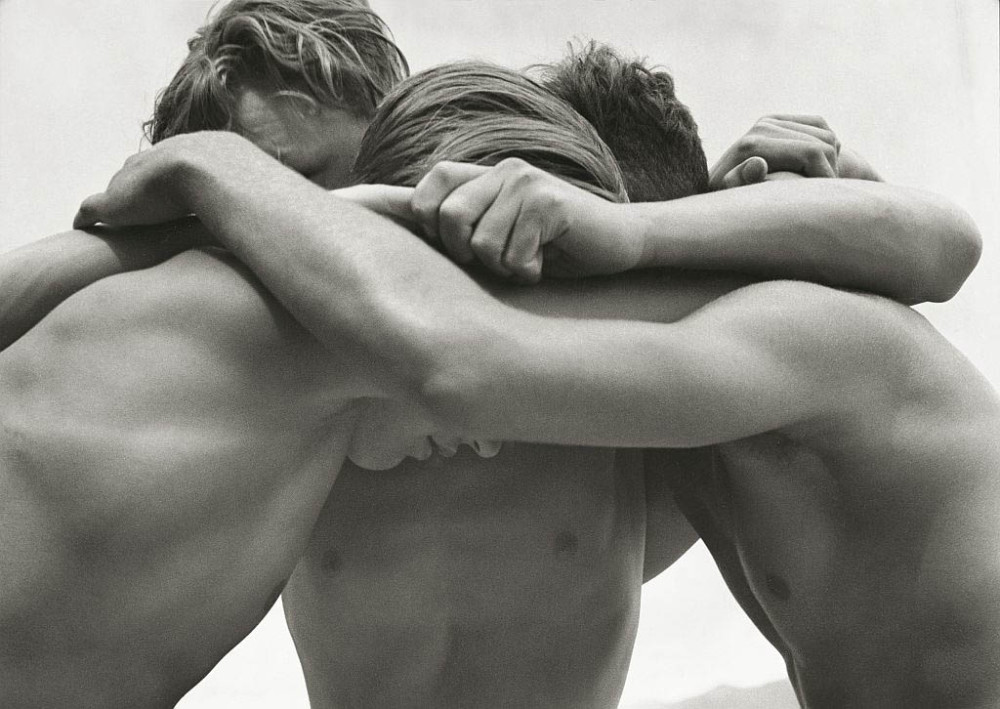
Wrestling boys on the Baltic Sea, 1933. Herbert List.
Pierre Seel mentions a cafe-concert dating from the reign of Louis-Philippe right in the centre of Mulhouse, where in an upstairs billiard room the town bourgeoisie made free with the young men from the park, and then descended to their wives and their aperitifs on the ground floor. It would be a pity if the word ‘homosexual’ were only applied to the park poor, to those who were caught.

A proportion of Jews murdered in the Holocaust must have been homosexual. Just as some of those arrested as homosexual must have been Jewish – Josef Kohout mentions one such prisoner, doubly stigmatised. They are all victims worthy of memory.
In a year when Ireland voted to legalise gay marriage and the US Supreme Court did the same, it seems appropriate to recognise and remember our brothers and sisters in arms from not so long ago.

(1) Heinz Heger. The Men with the Pink Triangle. GMP Publishers, 1980. / Die Männer mit dem Rosa Winkel. Merlin, 2011.
(2) Jean Le Bitoux. Les oubliés de la mémoire. Hachette Littératures, 2002.
Pierre Seel. Moi, Pierre Seel, déporté homosexuel. Calmann-Lévy, 1994. / I, Pierre Seel, Deported Homosexual: A Memoir of Nazi Terror. Penguin Books, 1995.


